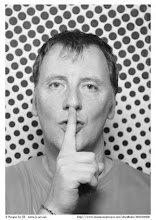
"Cut-ups are for everyone. Anybody can make cut-ups. It is experimental in the sense of being something to do. Right here write now. Not something to talk and argue about. Greek philosophers assumed logically that an object twice as heavy as another object would fall twice as fast. It did not occur to them to push the two objects off the table and see how they fall. Shakespeare Rimbaud live in their words. Cut the word lines and you will hear their voices. Cut- ups often come through as code messages with special meaning for the cutter. Table tapping? Perhaps. Certainly an improvement on the usual deplorable performances of contacted poets through a medium. Rimbaud announces himself, to be followed by some excruciatingly bad poetry. Cut Rimbaud's words and you are assured of good poetry at least if not personal appearance.
"All writing is in fact cut-ups. A collage of words read heard overheard. What else? Use of scissors renders the process explicit and subject to extension and variation. Clear classical prose can be composed entirely of rearranged cut-ups. Cutting and rearranging a page of written words introduces a new dimension into writing enabling the writer to turn images in cinematic variation. Images shift sense under the scissors smell images to sound sight to sound to kinesthetic. This is where Rimbaud was going with his color of vowels. And his "systematic derangement of the senses." The place of mescaline hallucination: seeing colors tasting sounds smelling forms.
"The cut-ups can be applied to other fields than writing. Dr Neumann in his Theory of Games and Economic behavior introduces the cut-up method of random action into game and military strategy: assume that the worst has happened and act accordingly. If your strategy is at some point determined . . . by random factor your opponent will gain no advantage from knowing your strategy since he cannot predict the move. The cut-up method could be used to advantage in processing scientific data. How many discoveries have been made by accident? We cannot produce accidents to order. The cut-ups could add new dimension to films. Cut gambling scene in with a thousand gambling scenes all times and places. Cut back. Cut streets of the world. Cut and rearrange the word and image in films. There is no reason to accept a second-rate product when you can have the best. And the best is there for all. Poetry is for everyone . . ." From Jenny Skerl's William Burroughs
Burroughs discovered the cutup in 1959 in Paris through his friend Brion Gysin , a painter. When Gysin began experimenting with cutups in his own work, Burroughs immediately saw the similarity to the juxtaposition technique he had used in Naked Lunch and began extensive experiments with text, often with the collaboration of other writers. (Although Burroughs has credited Gysin with discovering the cutup, he has also acknowledged similar literary experiments in the works of Tzara, Stein, Eliot, and Dos Passos.) In 1960 Burroughs published his initial cutup experiments in Paris in Minutes To Go (with Brion Gysin, Sinclair Beiles, and Gregory Corso) and in San Francisco in The Exterminator (with Brion Gysin), works that were partially intended to introduce the technique to the public. Throughout the 1960s Burroughs and Gysin collaborated on cutup experiments in many media, the most significant collaborations being three films done in 1965 with English film maker Antony Balch (Towers Open Fire, Cut-Ups, and Bill and Tony) and The Third Mind, a book first completed in 1965 but not published in English until 1978. The final version of The Third Mind is both a historical collection of cutup experiments from 1960 to 1978 and a manifesto that sums up the cutup's significance for Burroughs and Gysin.
Burroughs with his cut-ups
The cutup is a mechanical method of juxtaposition in which Burroughs literally cuts up passages of prose by himself and other writers and then pastes them back together at random. This literary version of the collage technique is also supplemented by literary use of other media. Burroughs transcribes taped cutups (several tapes spliced into each other), film cutups (montage), and mixed media experiments (results of combining tapes with television, movies, or actual events). Thus Burroughs's use of cutups develops his juxtaposition technique to its logical conclusion as an experimental prose method, and he also makes use of all contemporary media, expanding his use of popular culture.
Read more at: http://languageisavirus.com/articles/articles.php?subaction=showcomments&id=1099111044&archive=&start_from=&ucat

No comments:
Post a Comment